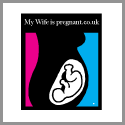Growing Baby 0-8 wks
Three weeks from the first day of your wife’s last menstrual period, the fertilised egg moves slowly along the fallopian tube towards the womb. The egg begins as one single cell. This cell divides again and again. By the time the egg reaches the womb it has become a mass of over 100 cells called an embryo. Once in the womb, the embryo burrows into the womb lining. This is called implantation.

In weeks four to five the embryo settles into the womb lining. The outer cells reach out like roots to link with the mother’s blood supply. The inner cells form into two and then later into three layers. Each of these layers will grow to be different parts of the baby’s body. One layer becomes the brain and nervous system, the skin, eyes and ears. Another layer becomes the lungs, stomach and gut. The third layer becomes the heart, blood, muscles and bones. The fifth week is the time of the first missed period, when most women are only just beginning to think they may be pregnant. Yet already the baby’s nervous system is starting to develop. A groove forms in the top layer of cells. The cells fold up and round to make a hollow tube called the neural tube. This will become the baby’s brain and spinal cord, so the tube has a ‘head end’ and a ‘tail end’.
At the same time the heart is forming and the baby already has some of its own blood vessels. A string of these blood vessels connects baby and mother and will become the umbilical cord.
By weeks six to seven there is a large bulge where the heart is and a bump for the head because the brain is developing. The heart begins to beat and can be seen beating on an ultrasound scan. Dimples on the side of the head will become the ears and there are thickenings where the eyes will be. On the body, bumps are forming that will become muscles and bones, and small swellings called limb buds show where the arms and legs are growing. At seven weeks the embryo has grown to about 10mm long from head to bottom. This measurement is called the ‘crown-rump length’.
Reference: http://www.nhs.uk/Planners/pregnancycareplanner/Pages/During.aspx



